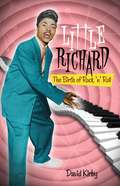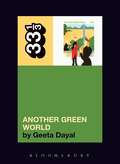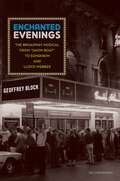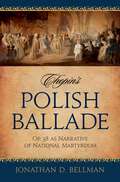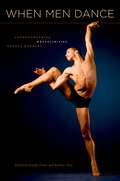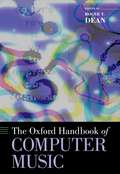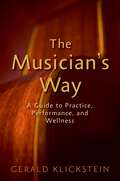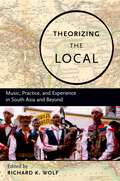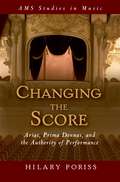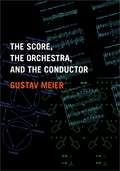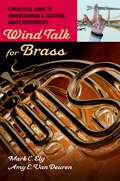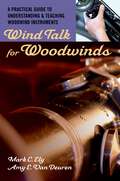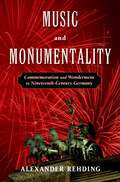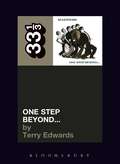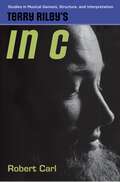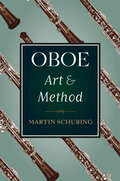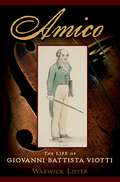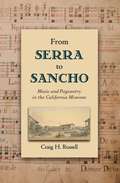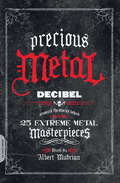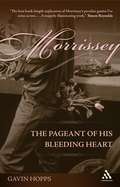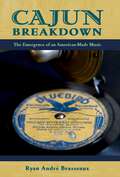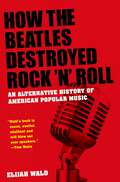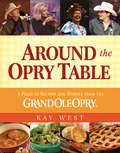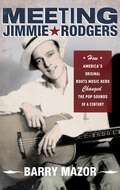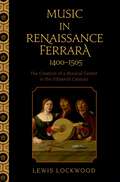- Table View
- List View
Little Richard: The Birth of Rock 'n' Roll
by David KirbyA brilliant new biography of the extraordinary, outrageous performer who helped open the floodgates of Rock 'n' Roll. In June, 2007, Little Richard's 1955 Specialty Records single, "Tutti Frutti," topped Mojo magazine's list of "100 Records That Changed the World." But back in the early 1950s, nobody gave Little Richard a second glance. It was a time in America where the black and white worlds had co-existed separately for nearly two centuries. After "Tutti Frutti," Little Richard began garnering fans from both sides of the civil rights divide. He brought black and white youngsters together on the dance floor and even helped to transform race relations.Little Richard: The Birth of Rock 'n' Roll begins by grounding the reader in the fertile soil from which Little Richard's music sprang. In Macon, Georgia, David Kirby interviews relatives and local characters, who knew Little Richard way back when, citing church and family as his true inspiration. His antics began as early as grade school, performing for his classmates every time the teacher would leave the room, connecting to an age-old American show biz tradition of charade and flummery. On the road, Little Richard faced competition from his peers, honing his stage show and making it, too, an act that could not be counterfeited.Kirby sees Little Richard as a foxy warrior, fighting with skill and cunning to take his place among the greats. In the words of Keith Richards (on hearing "Tutti Frutti" for the first time), "it was as though the world changed suddenly from monochrome to Technicolor." Those sentiments have consistently been echoed by the music-listening world, and the time is ripe for a reassessment of Little Richard's genius and legacy.
Brian Eno's Another Green World (33 1/3)
by Geeta DayalThe serene, delicate songs on Another Green World sound practicallymeditative, but the album itself was an experiment fueled byadrenaline, panic, and pure faith. It was the first Brian Eno album tobe composed almost completely in the confines of a recording studio,over a scant few months in the summer of 1975. The album was a proofof concept for Eno's budding ideas of "the studio as musicalinstrument," and a signpost for a bold new way of thinking aboutmusic.In this book, Geeta Dayal unravels Another Green World's abundantmysteries, venturing into its dense thickets of sound. How was analbum this cohesive and refined formed in such a seemingly ad hoc way?How were electronics and layers of synthetic treatments used to createan album so redolent of the natural world? How did a deck of cardsfigure into all of this? Here, through interviews and archivalresearch, she unearths the strange story of how Another Green Worldformed the link to Eno's future -- foreshadowing his metamorphosisfrom unlikely glam rocker to sonic painter and producer.
Enchanted Evenings: The Broadway Musical from 'Show Boat' to Sondheim and Lloyd Webber
by Geoffrey BlockThis new second edition of Enchanted Evenings offers theater lovers an illuminating behind-the-scenes tour of some of America's best loved, most admired, and most enduring musicals. Readers will find such all-time favorites as Show Boat, Carousel, Kiss Me, Kate, Guys and Dolls, My Fair Lady, West Side Story, Sweeney Todd, Sunday in the Park with George, and Phantom of the Opera. Geoffrey Block provides a documentary history of each of the musicals, showing how each work took shape and revealing, at the same time, how the American musical evolved from the 1920s to today, both on stage and on screen. The book's particular focus is on the music, offering a wealth of detail about how librettist, lyricist, composer, and director work together to shape the piece. Block also includes trenchant social commentary and lively backstage anecdotes. Jerome Kern, Cole Porter, the Gershwins, Rodgers and Hart, Kurt Weill, Rodgers and Hammerstein, Lerner and Loewe, Frank Loesser, Leonard Bernstein, Stephen Sondheim, Andrew Lloyd Webber, and other luminaries emerge as hardworking craftsmen under enormous pressure to sell tickets without compromising their dramatic vision. The second edition includes a greatly expanded chapter on Sondheim, a new chapter on Lloyd Webber, and two new chapters on the film adaptations of the main musicals featured in the text (including such hard to find films as the original 1936 version of Anything Goes and the 1959 film adaptation of Porgy and Bess). Packed with information, including a complete discography and plot synopses and song-by-song scenic outlines for each of the fourteen shows, Enchanted Evenings is an essential reference as well as a riveting history. "A solid and fascinating work that should become a model of how to investigate and report on the evolution of a musical. Block's research is persuasive and his writing vivid. . . Indispensable for anyone who cares to know more about Broadway musicals than Playbill can provide." --Steven Bach, The Los Angeles Times Book Review
Chopin's Polish Ballade: Op. 38 as Narrative of National Martyrdom
by Jonathan D. BellmanChopin's Polish Ballade examines the Second Ballade, Op. 38, and how that work gave voice to the Polish cultural preoccupations of the 1830s, using musical conventions from French opera and amateur piano music. This approach provides answers to several persistent questions about the work's form, programmatic content, and poetic inspiration.
When Men Dance: Choreographing Masculinities Across Borders
by Jennifer Fisher Anthony ShayWhen Men Dance explores the intersection of dance and perceptions of male gender and sexuality across history and different cultural contexts. Chapters tackle the history and dilemmas that revolve around dance and notions of masculinity from a variety of dance studies perspectives, and are accompanied by fascinating personal histories that complement their themes.
The Oxford Handbook of Computer Music (Oxford Handbooks)
The Oxford Handbook of Computer Music offers a state-of-the-art cross-section of the most field-defining topics and debates in computer music today. A unique contribution to the field, it situates computer music in the broad context of its creation and performance across the range of issues - from music cognition to pedagogy to sociocultural topics - that shape contemporary discourse in the field. Fifty years after musical tones were produced on a computer for the first time, developments in laptop computing have brought computer music within reach of all listeners and composers. Production and distribution of computer music have grown tremendously as a result, and the time is right for this survey of computer music in its cultural contexts. An impressive and international array of music creators and academics discuss computer music's history, present, and future with a wide perspective, including composition, improvisation, interactive performance, spatialization, sound synthesis, sonification, and modeling. Throughout, they merge practice with theory to offer a fascinating look into computer music's possibilities and enduring appeal.
The Musician's Way: A Guide to Practice, Performance, and Wellness
by Gerald KlicksteinIn The Musician's Way, veteran performer and educator Gerald Klickstein combines the latest research with his 30 years of professional experience to provide aspiring musicians with a roadmap to artistic excellence. Part I, Artful Practice, describes strategies to interpret and memorize compositions, fuel motivation, collaborate, and more. Part II, Fearless Performance, lifts the lid on the hidden causes of nervousness and shows how musicians can become confident performers. Part III, Lifelong Creativity, surveys tactics to prevent music-related injuries and equips musicians to tap their own innate creativity. Written in a conversational style, The Musician's Way presents an inclusive system for all instrumentalists and vocalists to advance their musical abilities and succeed as performing artists.
Theorizing the Local: Music, Practice, and Experience in South Asia and Beyond
by Richard WolfOver the past four decades, the "globalized" aspects of cultural circulation have received the majority of scholarly-and consumer-attention, particularly in the study of South Asian music. As a result, a broad range of community-based and other locally focused performance traditions in the regions of South Asia have remained relatively unexplored. Theorizing the Local provides a challenging and compelling counterperspective to the "globalized," arguing for the value of comparative microstudies that are not concerned primarily with the flow of capital and neoliberal politics. What does it mean for musical activities to be local in an increasingly interconnected world? To what extent can theoretical activity be localized to the very acts of making music, interacting, and composing? Theorizing the Local offers glimpses into rich musical worlds of south and west Asia, worlds which have never before been presented in a single volume. The authors cross the traditional borders of scholarship and region, exploring in unmatched detail a vast array of musical practices and significant ethnographic discoveries-from Nepal to India, India to Sri Lanka, Pakistan to Iran. Enriched by audio and video tracks on an extensive companion Web site, Theorizing the Local is an important study of South Asian musical traditions that offers a broader understanding of 21st-century music of the world.
Changing the Score: Arias, Prima Donnas, and the Authority of Performance (AMS Studies in Music)
by Hilary PorissThis study seeks to explore the role and significance of aria insertion, the practice that allowed singers to introduce music of their own choice into productions of Italian operas. Each chapter investigates the art of aria insertion during the nineteenth century from varying perspectives, beginning with an overview of the changing fortunes of the practice, followed by explorations of individual prima donnas and their relationship with particular insertion arias: Carolina Ungher's difficulties in finding a "perfect" aria to introduce into Donizetti's Marino Faliero; Guiditta Pasta's performance of an aria from Pacini's Niobe in a variety of operas, and the subsequent fortunes of that particular aria; Maria Malibran's interpolation of Vaccai's final scene from Giulietta e Romeo in place of Bellini's original setting in his I Capuleti e i Montecchi; and Adelina Patti's "mini-concerts" in the lesson scene of Il barbiere di Siviglia. The final chapter provides a treatment of a short story, "Memoir of a Song," narrated by none other than an insertion aria itself, and the volume concludes with an appendix containing the first modern edition of this short story, a narrative that has lain utterly forgotten since its publication in 1849. This book covers a wide variety of material that will be of interest to opera scholars and opera lovers alike, touching on the fluidity of the operatic work, on the reception of the singers, and on the shifting and hardening aesthetics of music criticism through the period.
The Score, the Orchestra, and the Conductor
by Gustav MeierKnown internationally for his work as a teacher of conducting, Gustav Meier's influence in the field cannot be overstated. In The Score, the Orchestra and the Conductor, Meier demystifies the conductor's craft with explanations and illustrations of what the conductor must know to attain podium success. He provides useful information from the rudimentary to the sophisticated, and offers specific and readily applicable advice for technical and musical matters essential to the conductor's first rehearsal with the orchestra. This book details many topics that otherwise are unavailable to the aspiring and established conductor, including the use of the common denominator, the "The ZIG-ZAG method", a multiple, cross-indexed glossary of orchestral instruments in four languages, an illustrated description of string harmonics, and a comprehensive listing of voice categories, their overlaps, dynamic ranges and repertory. The Score, the Orchestra and the Conductor is an indispensable addition to the library of every conductor and conducting student.
Wind Talk for Brass: A Practical Guide to Understanding and Teaching Brass Instruments
by Mark C. Ely Amy E. Van DeurenWind Talk for Brass provides instrumental music teachers, practitioners, and students with a handy, easy-to-use pedagogical resource for brass instruments found in school instrumental programs. With thorough coverage of the most common brass instruments - trumpet, horn, trombone, baritone/euphonium, and tuba/sousaphone - the book offers the most topical and information necessary for effective teaching. This includes terminology, topics, and concepts associated with each specific instrument, along with teaching suggestions that can be applied in the classroom. Be sure to look to the back of the book for a "Practical Tips" section, which discusses common technical faults and corrections, common problems with sound (as well as their causes and solutions to them), fingering charts, literature lists (study materials, method books, and solos), as well as a list of additional resources relevant to teaching brass instruments (articles, websites, audio recordings). Without question, Wind Talk for Brass stands alone as an invaluable resource for woodwinds!
Wind Talk for Woodwinds: A Practical Guide to Understanding and Teaching Woodwind Instruments
by Mark C. Ely Amy E. Van DeurenWind Talk for Woodwinds provides instrumental music teachers, practitioners, and students with a handy, easy-to-use pedagogical resource for woodwind instruments found in school instrumental programs. With thorough coverage of the most common woodwind instruments - flute, oboe, clarinet, saxophone, and bassoon - the book offers the most topical and information necessary for effective teaching. This includes terminology, topics, and concepts associated with each specific instrument, along with teaching suggestions that can be applied in the classroom. Be sure to look to the back of the book for a "Practical Tips" section, which discusses common technical faults and corrections, common problems with sound (as well as their causes and solutions to them), fingering charts, literature lists (study materials, method books, and solos), as well as a list of additional resources relevant to teaching woodwind instruments (articles, websites, audio recordings). Without question, Wind Talk for Woodwinds stands alone as an invaluable resource for woodwinds!
Music and Monumentality: Commemoration and Wonderment in Nineteenth Century Germany
by Alexander RehdingThis critical study locates musical monumentality, a central property of the nineteenth-century German repertoire, at the intersections of aesthetics and memory. In examples including Beethoven, Liszt, Wagner and Bruckner, Rehding explores how monumentality contributes to an experiential music history and how it conveys the sublime to the listening public.
Madness' One Step Beyond... (33 1/3)
by Terry EdwardsOne Step Beyond isn't the best album in the world - it's not even the best album by Madness. It is, however, a great record and an exceptional debut album -fully formed despite half the band still being in their teens - and it remains as exhilarating, inspiring and as much fun as when people first heard it nearly 30 years ago. Through extensive interviews with the band, as well as producers Clive Langer & Alan Winstanley, Terry Edwards tells the inside story of how Madness rose to be the most successful singles band of the 1980s in the UK charts.
Terry Riley's In C (Studies in Musical Genesis, Structure, and Interpretation)
by Robert CarlSetting the stage for a most intriguing journey into the world of minimalism, Robert Carl's Terry Riley's In C argues that the work holds its place in the canon because of the very challenges it presents to "classical" music. Carl examines In C in the context of its era, its grounding in aesthetic practices and assumptions, its process of composition, presentation, recording, and dissemination.
Oboe Art and Method
by Martin SchuringIn Oboe Art and Method, veteran oboe performer and instructor Martin Schuring describes in detail all of the basic techniques of oboe playing and reed making, with expert tips and step-by-step instructions for how best to perform each of these tasks with grace and technical efficiency. Schuring's straightforward and articulate explanations of breathing, embouchure, finger technique, articulation, phrasing, and more help demystify the earliest stages of oboe playing and beyond. In addition, Schuring provides excellent advice on the "extra-musical"; practicing, instrument care and adjustment, professional development, and career development-related issues. The oboe is a notoriously complicated instrument, and this book aims to remove as much of the complexity as possible, to present techniques that work, and to discuss these in a clear-cut manner. Students who start with this book will learn with confidence that these methods will steer them straight down an effective path. A concise and eminently useful guide, Oboe Art and Method is a must-have for all who perform, teach, or are learning to play the oboe, in both conservatories and private instruction.
Amico: The Life of Giovanni Battista Viotti
by Warwick ListerThis is the first full-length biography in English of Giovanni Battista Viotti (1755-1824), one of the great violinist-composers in the history of music, and arguably the most influential violinist who ever lived. This study is based on extensive documentary research, much of it here revealed for the first time.
From Serra to Sancho: Music and Pageantry in the California Missions (Currents in Latin American and Iberian Music)
by Craig H. RussellMusic in the California missions was a pluralistic combination of voices and instruments, of liturgy and spectacle, of styles and functions--and even of cultures--in a new blend that was non-existent before the Franciscan friars made their way to California beginning in 1769. From Serra to Sancho explores the exquisite sacred music that flourished on the West Coast of the United States when it was under Spanish and Mexican rule, delving into the historical, cultural, biographical, and stylistic aspects of California mission music during the late eighteenth and early nineteenth centuries. Author Craig H. Russell examines how mellifluous plainchant, reverent hymns, spunky folkloric ditties, "classical" music in the style of Haydn, and even Native American drumming were interwoven into a tapestry of resonant beauty. In addition to extensive musical and cultural analysis, Russell draws upon hundreds of primary documents in California, Mexico, Madrid, Barcelona, London, and Mallorca. It is through the melding together of this information from geographically separated places that he brings the mystery of California's mission music into sharper focus. Russell's groundbreaking study sheds new light on the cultural exchange that took place in the colonial United States, as well as on the pervasive worldwide influence of Iberian music as a whole.
Precious Metal: Decibel Presents the Stories Behind 25 Extreme Metal Masterpieces
by Albert MudrianDecibel magazine is regarded as the best extreme music magazine around.Precious Metal gathers pieces from Decibel's most popular feature, the monthly &“Hall of Fame&” which documents the making of landmark metal albums via candid, hilarious, and fascinating interviews with every participating band member.Decibel's editor-in-chief Albert Mudrian, has selected and expanded the best of these features, creating a definitive collection of stories behind the greatest extreme metal albums of all time.
Morrissey: The Pageant of His Bleeding Heart
by Gavin HoppsMorrissey is arguably the greatest disturbance popular music has ever known. Even more than the choreographed carelessness of punk and the hyperbolic gestures of glam rock and the New Romantics, Morrissey's early bookish ineptitude, his celebration of the ordinary, and his subversive endorsement of celibacy, abstinence and rock 'n' roll revolutionized the world of British pop. As a solo artist, too, he consistently adopts the outsider's perspective and dares us to confront uncomfortable subjects. In his brilliant book, Gavin Hopps examines the work of this compelling performer, whose intelligence, humour, suffering and awkwardness have fascinated audiences around the world for the last 25 years.Hopps traces the trajectory of Morrissey's career and outlines the contours and contradictions of the singer's elusive persona. The book illuminates Morrissey's coyness (how can he remain a mystery when he tells us too much?), his dramatized melancholy (surely more of a radical existential protest than the gimmick some believe it to be), and his complex attitudes towards loneliness and alienation, as well as his intriguing sense of the religious.
Cajun Breakdown: The Emergence of an American-Made Music (American Musicspheres)
by Ryan Andre BrasseauxIn 1946, Harry Choates, a Cajun fiddle virtuoso, changed the course of American musical history when his recording of the so-called Cajun national anthem "Jole Blon" reached number four on the national Billboard charts. Cajun music became part of the American consciousness for the first time thanks to the unprecedented success of this issue, as the French tune crossed cultural, ethnic, racial, and socio-economic boundaries. Country music stars Moon Mullican, Roy Acuff, Bob Wills, and Hank Snow rushed into the studio to record their own interpretations of the waltz-followed years later by Waylon Jennings and Bruce Springsteen. The cross-cultural musical legacy of this plaintive waltz also paved the way for Hank Williams Sr.'s Cajun-influenced hit "Jamabalaya." Choates' "Jole Blon" represents the culmination of a centuries-old dialogue between the Cajun community and the rest of America. Joining into this dialogue is the most thoroughly researched and broadly conceived history of Cajun music yet published, Cajun Breakdown. Furthermore, the book examines the social and cultural roots of Cajun music's development through 1950 by raising broad questions about the ethnic experience in America and nature of indigenous American music. Since its inception, the Cajun community constantly refashioned influences from the American musical landscape despite the pressures of marginalization, denigration, and poverty. European and North American French songs, minstrel tunes, blues, jazz, hillbilly, Tin Pan Alley melodies, and western swing all became part of the Cajun musical equation. The idiom's synthetic nature suggests an extensive and intensive dialogue with popular culture, extinguishing the myth that Cajuns were an isolated folk group astray in the American South. Ryan André Brasseaux's work constitutes a bold and innovative exploration of a forgotten chapter in America's musical odyssey.
How the Beatles Destroyed Rock 'n' Roll: An Alternative History of American Popular Music
by Elijah Wald"There are no definitive histories," writes Elijah Wald, in this provocative reassessment of American popular music, "because the past keeps looking different as the present changes." Earlier musical styles sound different to us today because we hear them through the musical filter of other styles that came after them, all the way through funk and hip hop. As its blasphemous title suggests, How the Beatles Destroyed Rock 'n' Roll rejects the conventional pieties of mainstream jazz and rock history. Rather than concentrating on those traditionally favored styles, the book traces the evolution of popular music through developing tastes, trends and technologies--including the role of records, radio, jukeboxes and television --to give a fuller, more balanced account of the broad variety of music that captivated listeners over the course of the twentieth century. Wald revisits original sources--recordings, period articles, memoirs, and interviews--to highlight how music was actually heard and experienced over the years. And in a refreshing departure from more typical histories, he focuses on the world of working musicians and ordinary listeners rather than stars and specialists. He looks for example at the evolution of jazz as dance music, and rock 'n' roll through the eyes of the screaming, twisting teenage girls who made up the bulk of its early audience. Duke Ellington, Benny Goodman, Frank Sinatra, Elvis Presley, Chuck Berry, and the Beatles are all here, but Wald also discusses less familiar names like Paul Whiteman, Guy Lombardo, Mitch Miller, Jo Stafford, Frankie Avalon, and the Shirelles, who in some cases were far more popular than those bright stars we all know today, and who more accurately represent the mainstream of their times. Written with verve and style, How the Beatles Destroyed Rock 'n' Roll shakes up our staid notions of music history and helps us hear American popular music with new ears.
Around the Opry Table: A Feast of Recipes and Stories from the Grand Ole Opry
by Kay WestCountry music and country cooking fans everywhere will savor this new official cookbook of the Grand Ole Opry and its members, featuring favorite recipes of country music legends past and present and the stories behind them.
Meeting Jimmie Rodgers: How America's Original Roots Music Hero Changed the Pop Sounds of a Century
by Barry MazorIn Meeting Jimmie Rodgers, the first book to explore the deep legacy of "The Singing Brakeman" from a twenty-first century perspective, Barry Mazor offers a lively look at Rodgers' career, tracing his rise from working-class obscurity to the pinnacle of renown that came with such hits as "Blue Yodel" and "In the Jailhouse Now." As Mazor shows, Rodgers brought emotional clarity and a unique sense of narrative drama to every song he performed, whether tough or sentimental, comic or sad. His wistful singing, falsetto yodels, bold flat-picking guitar style, and sometimes censorable themes--sex, crime, and other edgy topics--set him apart from most of his contemporaries. But more than anything else, Mazor suggests, it was Rodgers' shape-shifting ability to assume many public personas--working stiff, decked-out cowboy, suave ladies' man--that connected him to such a broad public and set the stage for the stars who followed him. In reconstructing this far-flung legacy, Mazor enables readers to meet Rodgers and his music anew-not as an historical figure, but as a vibrant, immediate force.
Music in Renaissance Ferrara 1400-1505: The Creation of a Musical Center in the Fifteenth Century
by Lewis LockwoodBased on extensive documentary and archival research, Music in Renaissance Ferrara is a documentary history of music for one of the most important city-states of the Italian Renaissance. Lockwood shows how patrons and musicians created a musical center over the course of the fifteenth-century, tracing the growth of music and musical life in rich detail. It also sheds new light on the careers of such important composers as Dufay, Martini, Obrecht, and Josquin Desprez. This paperback edition features a new preface that re-introduces the book and reflects on its contribution to our modern knowledge of music in the culture of the Italian Renaissance.
